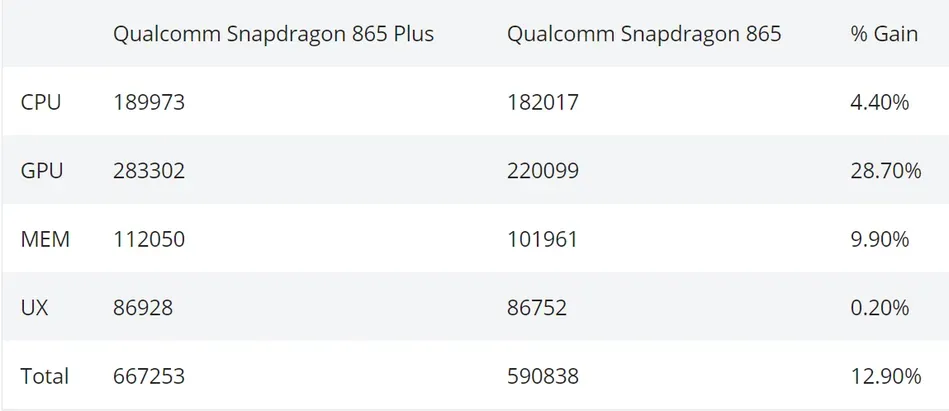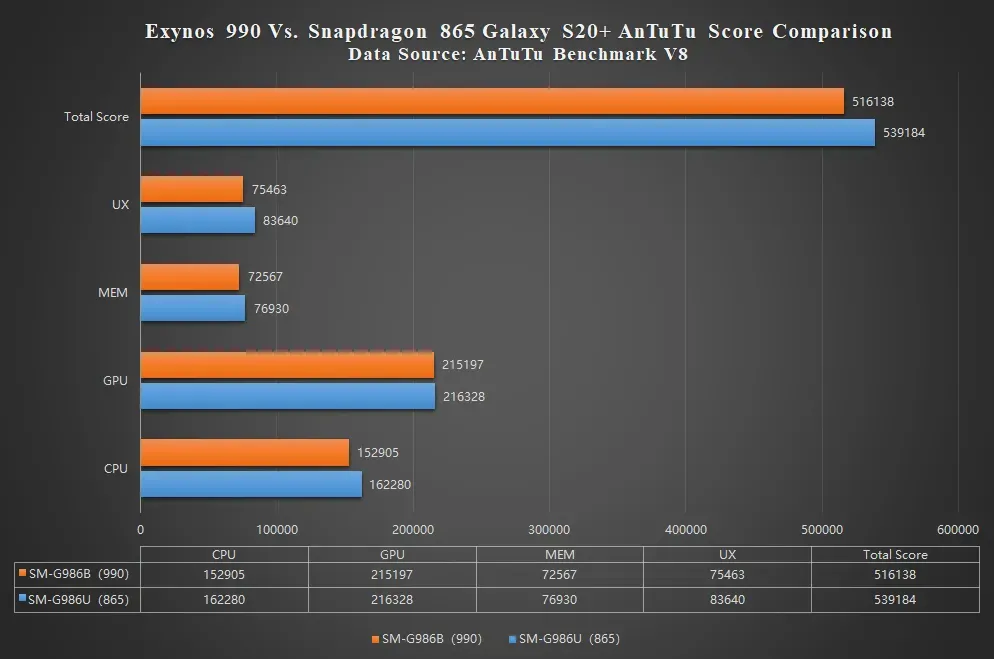
It all started with Asus back in 2018 with Asus ROG Phone original. Asus in ROG Phone Original used an overclocked Snapdragon 845 Chipset to taunt about its gaming capabilities and to make up for the interest of the gaming enthusiasts. Later the same year, Seizing the opportunity, and widening the reach, Snapdragon made this overclocked Chipset official as Snapdragon 845 Plus, starting a new trend. Since then, Asus ROG Phones are the first smartphones of any year to come with an overclocked Snapdragon plus moniker. With the history told, let's get back to the main topic.
Both Snapdragon 865 and Snapdragon 865 plus are essentially the same chipsets, with Snapdragon 865+ being slightly overclocked compared to the original Snapdragon 865, resulting in a 10% performance boost.
.webp)
With the given performance boost, Qualcomm Snapdragon 865 Plus becomes the first mobile chipset to cross 3.0 GHz clock speed, making it the fastest android chipset available in the market.
Both Snapdragon 865 and Snapdragon 865+ are octa-core chipsets, but there lies an architectural difference. And the architectural difference is the main reason behind Snapdragon 865+ performance boost.
Snapdragon 865 is composed of 4 Kryo 585 Prime cores clocked at 2.42 GHz, and 4 Kryo 585 Silver cores clocked at 1.8 GHz. The idea behind is to use less powerful Kryo 585 Silver cores to handle light tasks and Kryo Prime cores to handle heavy tasks for better power efficiency.
snapdragon 865
Snapdragon 865+, on the other hand, is composed of 3 Kryo 585 Prime cores clocked at 2.42 GHz, and 4 Kryo 585 Silver cores clocked at 1.8 GHz, same as that of Snapdragon 865. The missing Kryo 585 Prime Core of Snapdragon 865+ comes clocked at 3.09 GHz, almost 200 MHz increase in clock speed as compare to original Snapdragon 865. This overclocked Kryo 585 Prime makes up for that 10% extra performance about 60000 AnTuTu points.
Snapdragon 865+
Here is the AnTuTu benchmark comparison of two Snapdragon beasts given below.

As can be seen in the image, Snapdragon 865+ gains a significant lead in almost every aspect of comparison. In CPU performance, Snapdragon 865+ is 4.40% more efficient than Snapdragon 865. In the MEM test, Snapdragon 865+ gains a lead of 10% over Snapdragon 865 (MEM Test explanation given below). But, GPU is where the Snapdragon truly excels and completely wash off original Snapdragon 865 with a solid lead of 28.70%.
At this point, there is no Android smartphone powered by any other chipset in the market to come even close to Snapdragon 865+ total of 667253 in the AnTuTu benchmark. The closest ones in the list again come powered by original Snapdragon 865. Below is the given list of top 10 Smartphones of July 2020 in terms of raw performance.

As you can see in the image given above, The most powerful smartphone to come close to the performance of Snapdragon 865+ is OPPO Find X2, which comes powered via Snapdragon 865 under its hood paired with 12GB of RAM. However, even with such great specifications, OPPO Find X2 manages to score a total of 604805, Snapdragon 865+ is whole 50000 marks ahead.
MEM test is essentially a memory management test that checks how efficiently a chipset manages memory allotment. You can see the MEM test as a RAM test because everything you see on a smartphone is nothing but apps loaded on a Smartphone's RAM, once you boot it.
In fact, Android itself is based on the Unix (modifies Linux Kernel) operating system made out of Linux, written mainly in Java, C, and C++ languages. It is due to this nature of RAM usage in a smartphone that you never get your marketed RAM completely free, But in a laptop, you get all of your RAM completely free always ready for relocation.
You might like to read this interesting article on how much RAM a smartphone actually needs? The article is quite interesting and explains in short why laptops are more powerful than any smartphone even with a lower memory configurations.
So, Snapdragon 865+ is a significant upgrade over original Snapdragon 865, but how well it stands up against the second most powerful mobile chipset of the market Exynos 990. Given below is the side by side comparison of Exynos 990 with Snapdragon 865 and not Snapdragon 865+.

As you can see in the image, Snapdragon 865 outscored Exynos 990 is almost every aspect of comparison. The lead may not sound significant on paper, but in real life, there's a whole new story. Moreover, Snapdragon 865+ is already way more powerful than the original Snapdragon 865, which means that Exynos stands nowhere near it. And just hearing that the recently launched Samsung Galaxy Note 20 Duo will come powered by either a newly launched Snapdragon 865+ or an Exynos 990 based on the market sounds injustice to me, since Snapdragon 865+ belongs to a whole different league. Read quick hands on review of Samsung Galaxy Note 20 series here

More to it, Exynos 990 is suffering from some serious throttling issues and heats like an iron stab during gaming. With this, I highly doubt the sales figures of Note series smartphones in India and Europe as both of them will get only the Exynos variant.
Overclocking means to run something at speed higher than what it is destined to be. It's like running a motorbike made to run at speed no more than 140Km/h at 160Km/h by tweaking its engine. It's a bad idea, and more or less, the same goes for mobile chipsets.

Running a mobile chipset at a higher clock speed requires more power and produces more heat. And this is the reason why playing games on mobile drinks a lot of battery and make it hot. Playing Games require GPU (Graphics Processing Unit) usage, More GPU usage means more heat production, and more raw GPU power comes with higher clock speeds.
So, should you be worried? Absolutely Not. The latest smartphones featuring overclocked chipsets come with fine-tuned hardware. For example, Asus ROG Phone 3 is a gaming smartphone, it has got a dedicated heat dissipation chamber bigger than any other smartphone. The same goes for recently launched Samsung Galaxy Note series smartphones.
Moreover, CPU continuously monitors smartphone temperature, and if the temperature goes too high (high enough to damage smartphone internals) due to high GPU Usage, it immediately applies a brake to it, this breaking is called as thermal throttling.
Thermal throttling happens for our smartphone well is a protective measure to ensure our smartphone longevity. Playing a game or doing some GPU extensive task requires a lot of graphics processing power, and a load of heat is produced. When our smartphone cooling system fails to dissipate this produced heat fast enough to keep the temperature of a smartphone within a safe range, the CPU emits an inhibitory signal, and GPU performance is dumped off to shed heat. This process is called thermal throttling.

1 year ago

1 year ago

1 year ago

1 year ago